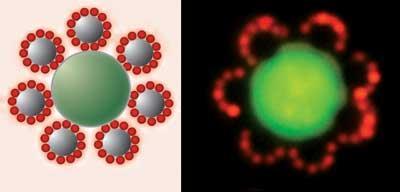'Nano-flowers' self-assemble under magnetic fields
US researchers have found a new way to use magnetic fields to encourage nanoparticles to self-assemble into unique shapes, including ’flowers’ made from particle rings. The process should provide access to some novel nanomaterials with useful properties, say the team.
’What we’re doing is mixing together different nanoparticles in a ferrofluid - which is essentially magnetic iron oxide nanoparticles suspended in water,’ says Benjamin Yellen, who led the research at Duke University, North Carolina, US. ’When a magnetic field is applied to this suspension, structures such as rings or poles form in the liquid.’

Typically, when a magnetic field is applied to a suspension of magnetic particles, they behave like dipoles - aligning with the field and forming chains. But Yellen’s team found that when the suspension contains a certain mix of magnetic and non-magnetic particles, different shapes can form.
The reason for this, Yellen explains, is that each magnetic bead becomes a tiny magnet producing its own field. This field is lowest around its equator, so smaller non-magnetic nanoparticles prefer to arrange themselves side-by-side in a ring around the bead.
However, as soon as the magnetic field is released, the structures dissolve back into chaos. To solve this problem, the team developed chemistry to glue the beads together when they become close. They added amine groups to the surface of polystyrene nanoparticles and dosed the ferrofluid with small amounts of glutaraldehyde - a short chain molecule with aldehyde groups at each end. This functions as a linker, forming strong peptide bonds between the nanoparticles to stick them together.
’What we end up with is a bunch of nanoparticle rings that we can isolate and purify,’ Yellen says. ’Another interesting thing we can do is put the rings back into the magnetic solution and make more shapes out of them - such as long chains of rings, or "flower" shapes - made from rings of rings.’
Since the process could be applied to any non-magnetic material, including silicon, gold or silver, there is great potential for future investigations. The team are also confident that the technique can be scaled-up to produce novel nanomaterials cheaply and easily. Investigations into the optical properties of the nano-scale rings are already underway. Since they are only a few micrometres across, it’s possible that they could act as infrared antennae, Yellen says. This would make them an interesting component for ’metamaterials’, which are currently being investigated for their potential invisibility cloaking devices.
Simon Biggs, an expert on particle engineering at the University of Leeds, UK, is intrigued by the work. ’The results are very interesting,’ he told Chemistry World. ’But to become commercially viable, a number of issues will need to be addressed - such as ensuring that useful quantities can be made in a reproducible and cost-effective way.’
Lewis Brindley
References
R Erb et al, Nature, 2009, DOI:10.1038/nature07766






No comments yet